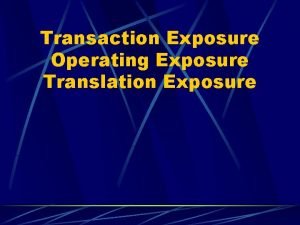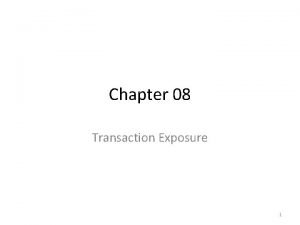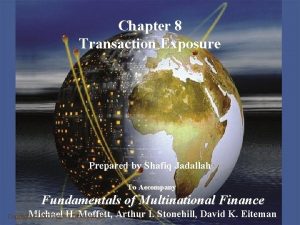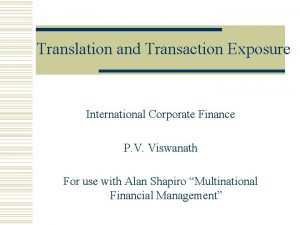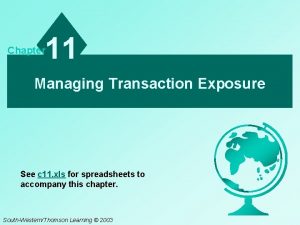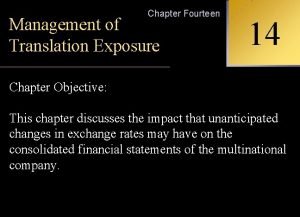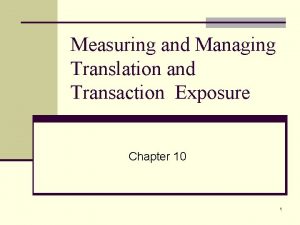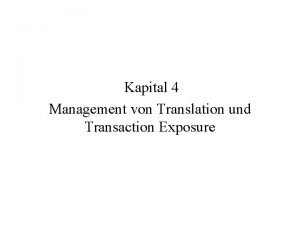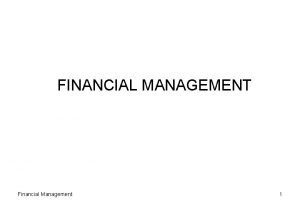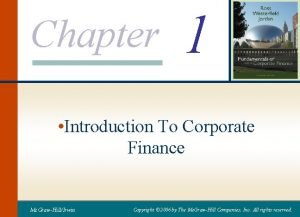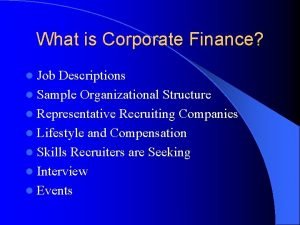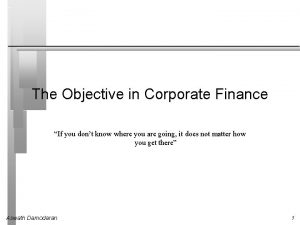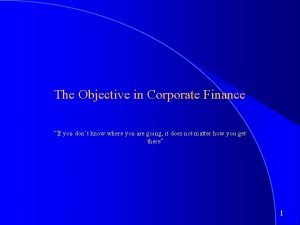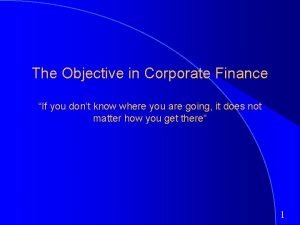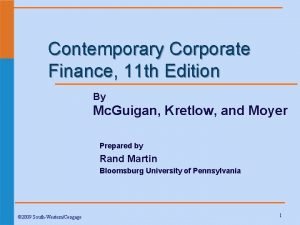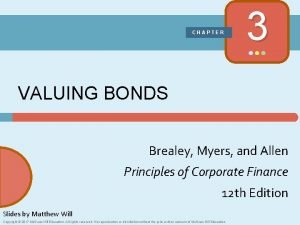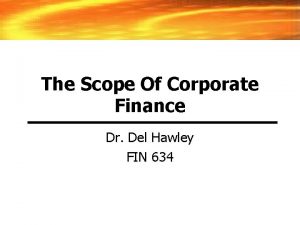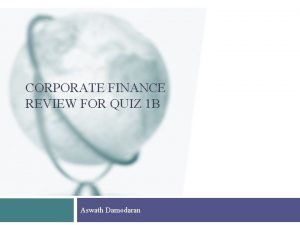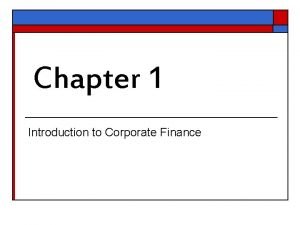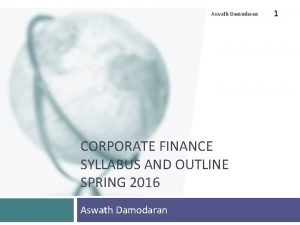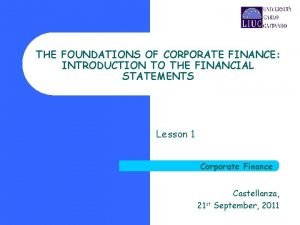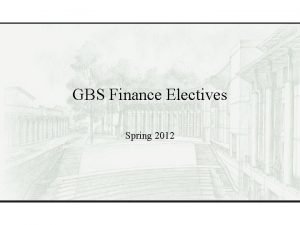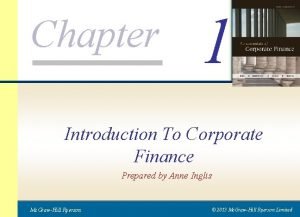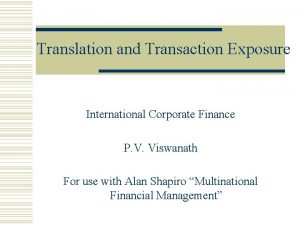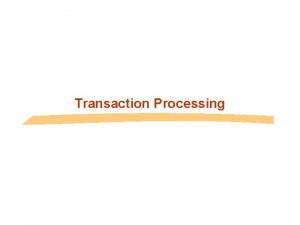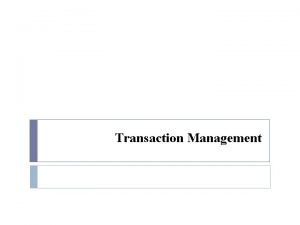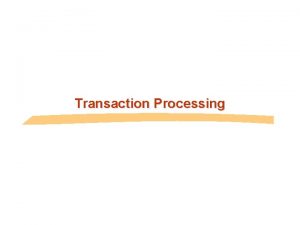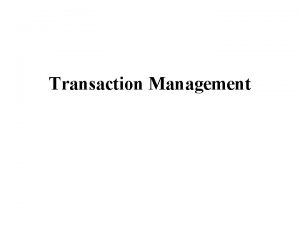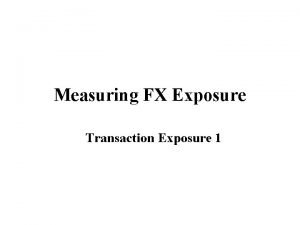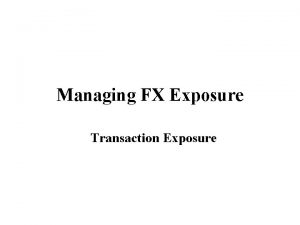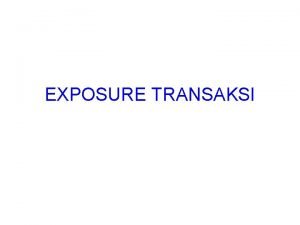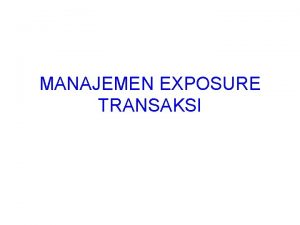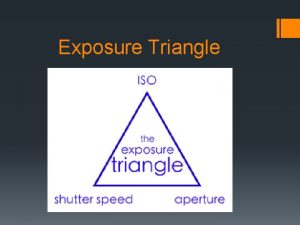Translation and Transaction Exposure International Corporate Finance P














































- Slides: 46

Translation and Transaction Exposure International Corporate Finance P. V. Viswanath For use with Alan Shapiro “Multinational Financial Management”

Learning Objectives w To define translation and transaction exposure w To describe the four principal currency translation methods. w To describe and apply the FASB-52 currency translation method w Different Hedging Strategies P. V. Viswanath 2

Exchange Risk w Definition: A gain/loss that results due to an exchange rate change. w Only unanticipated exchange rate changes constitute risk. w Question: Whose gain or loss? w Ans: The subsidiary’s? The parent’s? No, the shareholder’s. w However, the link between exchange risk and shareholder value is weak. w If a shareholder has a diversified portfolio, then the negative effect of exchange rate changes on one firm might be offset by the positive effect on another firm. w Also, even if there is no offset, let the shareholder do the hedging. P. V. Viswanath 3

Justifications for Corporate Hedging w Assessment of exposure to exchange rate risk requires estimates of susceptibility of net cashflows to unexpected exchange rate changes. Operating managers can make these estimates more precisely. w The firm can hedge cheaper. w Nominal exchange rate changes should not translate into real exchange rate changes if PPP holds; however, deviations from PPP can persist. w Increased firm level exposure to exchange risk can lead to bankruptcy and its attendant costs; hence it may be optimal for firms to hedge against exchange rate risk. P. V. Viswanath 4

Translation Exposure w There are three kinds of exposure. w Translation (accounting) exposure, arises from the need for purposes of reporting and consolidation to convert the financial statements of foreign subsidiaries from local currencies (LC) to the home currency (HC). w If exchange rates have changed since the previous reporting period, translation/restatement of those assets/liabilities, revenues/expenses that are denominated in foreign currencies will result in foreign exchange gains or losses. P. V. Viswanath 5

Transaction Exposure w Transaction exposure results from transactions that give rise to known, contractually binding future foreign-currencydenominated cash flows. As exchange rages change between now and when these transactions settle, so does the value of their associated foreign currency cashflows, leading to currency gains and losses w For example, accounts receivable associated with a sale denominated in euros or the obligation to repay a Japanese yen debt. P. V. Viswanath 6

Operating Exposure w The extent to which currency fluctuations can alter a company’s future operating cash flows, i. e. its future revenues and costs. w Any company whose revenues or costs are affected by currency changes has operating exposure, even if it is a purely domestic corporation and has all of its cashflows denominated in the home currency. w Operating and Transactions Exposure together are referred to as Economic Exposure P. V. Viswanath 7

Types of Exposure: Accounting, Operating and Transaction P. V. Viswanath 8

Comparison of Exposure Types P. V. Viswanath 9

Translation Methods w Income statements of foreign affiliates are usually translated according to the following rules: n n n Sales revenue and interest are translated at the average historical exchange rate that prevailed during the period Depreciation is translated at the appropriate historical exchange rate. Some of the general and administrative expenses as well as cost-ofgoods-sold are translated at historical exchange rates, others at current rates. w This is based on when the expenses were incurred. w However, there are different methods for translating assets and liabilities. w The various methods differ in terms of how exchange rate changes are presumed to impact the value of individual categories of assets and liabilities. P. V. Viswanath 10

Current/Noncurrent Currency Translation Method w Maturity is used to divided assets into two categories. Not in general use at the moment. w All the foreign subsidiary’s current assets/liabilities are translated to the HC at the current exchange rate; only these are presumed to change in value when the local currency appreciates/depreciates. w The underlying assumption is that rates are essentially fixed but subject to occasional adjustments that correct themselves in time. This was generally true in the Bretton Woods era. w Each non-current asset/liability is translated at its historical exchange rate – the rate at the time the asset was acquired or the liability incurred. w The income statement is translated at the average exchange rate of the period, except for revenues and expense items associated with noncurrent assets or liabilities. w These latter, such as depreciation expense, are translated at the same rate as the corresponding balance sheet items. P. V. Viswanath 11

Monetary/Nonmonetary Method w Monetary assets/liabilities are those items that represent a claim to receive or an obligation to pay a fixed amount of foreign currency, e. g. cash, A/P, A/R, long-term debt; they are translated at the current rate. w Nonmonetary refers to physical assets or liabilities (e. g. inventory, fixed assets, long-term investments); they are translated at at historical rates. w I/S items are translated at the average exchange rate during the period except for revenue and expense items related to nonmonetary assets/liabilities. w These are translated at the same rate as the corresponding B/S items. w The underlying assumption is that the local currency value of monetary assets increases immediately after a devaluation so that there is full compensation for the exchange rate change (Law of One Price). P. V. Viswanath 12

Temporal Method w The choice of exchange rate for translation is based on the underlying approach to evaluating cost (historical/market). If an item is carried on the balance sheet of the affiliate at its current value, it is translated using the current exchange rate. Items carried at historical cost are translated at the historical rate. w Modified version of the monetary/nonmonetary method. Under the monetary/nonmonetary method, inventory is always translated at the historical rate. Under the temporal method, inventory is normally translated at the historical rate, but it can be translated at the current rate if the inventory is shown on the balance sheet at market value. w I/S items are normally translated at an average rate for the reporting period. However, cost of goods sold and depreciation charges related to balance sheet items carried at past prices are translated at historical rates. P. V. Viswanath 13

FASB 8 w In 1975, FASB 8 required the temporal method: Monetary assets/liabilities at current exchange-rate l Fixed assets at historical exchange rate Translation gains & losses reported in income statement, creating volatile reported earnings l n w Example: U. S. parent firm issues DM bonds & builds German factory; DM revenues cover DM coupon payments; little operating exposure w Under FASB 8: n n n Factory is fixed asset, evaluated at historical rate, unaffected by rate changes DM debt is a monetary liability, evaluated at current rate; affected by rate changes Hence, enormous translation exposure and volatile earnings statements

Current/Current Method w At the end of 1981, FASB 52 required the current/current method to allow more flexibility. w All B/S items are translated at the current rate; I/S translated at current rate or appropriately weighted average exchange rate for period. (See Sterling case. ) w A variation is to translate all items except net fixed assets at the current rate; net fixed assets are translated at the historical rate. w If a firms’ foreign-currency denominated assets exceed its foreign-currency denominated liabilities, a devaluation results in a loss and a revaluation in a gain. w Translation losses moved to special sub-account in the net worth section of balance sheet, reducing income volatility. P. V. Viswanath 15

Impact of Translation Alternatives P. V. Viswanath 16

Impact of Translation Alternatives P. V. Viswanath 17

FASB 52 and the functional currency w Under FASB 52, affiliates’ financial statements must be first converted to the functional currency using the temporal method and then translated into the home currency before being included in the parent’s statements. w This gives firms the opportunity to identify the primary economic environment and select the appropriate functional currency for each subsidiary. An affiliate’s functional currency is the currency of the primary economic environment in which the affiliate generates and expends cash. w Location does not automatically indicate the right functional currency. For example, the functional currency is the dollar for a HK assembly plant for radios that sources components in the US and sells the assembled radios in the US. w However, in the case of a hyperinflationary environment, the dollar must be used as the functional currency. w In practice, all US firms either use the local foreign currency (80%) or the dollar (20%)as the functional currency. P. V. Viswanath 18

P. V. Viswanath 19

Functional Currency/ Reporting Currency w The reporting currency is the currency in which the parent firm prepares its own financial statements. w At each balance sheet date, any assets/liabilities denominated in a currency other than the functional currency of the affiliate must be adjusted to reflect the current exchange rate on that date. w If the dollar is the functional currency, then local currency accounts are translated into dollars using the temporal method. w Transaction gains/losses from such adjustments must appear on the affiliate’s income statement, with some exceptions. Obviously, if the functional currency is judiciously chosen, these will be minimal. w After all financial statements have been converted into the functional currency, these are then translated into dollars – translation gains/losses flow directly into the parent’s foreign exchange equity account. P. V. Viswanath 20

Example of FASB-52 Translation w Sterling Ltd. is the British subsidiary of a US company; started business and acquired fixed assets when the exchange rate was £ 1=$1. 50. w The average exchange rate for the period was $1. 40 w The rate at the end of the period was $1. 30. w The historical rate for investory was $1. 45. w During the year, Sterling has income after tax of £ 20 m. which goes into retained earnings. No dividends are paid. P. V. Viswanath 21

Example of FASB-52 Translation P. V. Viswanath 22

Example of FASB-52 Translation P. V. Viswanath 23

Example of FASB-52 Translation w We see that if the pound is the functional currency, Sterling will have a translation loss of $22 m. , which bypasses the I/S and appears on the B/S as a separate item. w The translation loss is calculated as the number that reconciles the equity account with the remaining translated accounts to balance assets with liabilities and equity. w If the dollar is the functional currency, there is a gain of $108 m. , which appears on Sterling’s income statement. w This is calculated as the difference between translated income before currency gains ($23 m. ) and the retained earnings figure ($131 m. ) P. V. Viswanath 24

Implications of FASB 52 w Fluctuations in local reported earnings are reduced significantly under FASB-52 when the local currency is the functional currency, compared to when the US dollar is used as the functional currency. n When the $ is the functional currency, translation losses/gains show up in the Income Statement. w Key financial ratios and relationships remain the same after translation into dollars under FASB-52, when the local currency is used as the functional currency, as they are in the local currency financial statements. n This is because the current/current method is used to convert into dollars; hence the same exchange rate is used for all items in the B/S (exchange rate on reporting date) and the same exchange rate for all items in the I/S (average rate for period in Sterling case). P. V. Viswanath 25

Exception to functional currency losses w Under FASB 52, the following gains/losses need not be included on the foreign unit’s income statement: n n n Gains/losses due to foreign currency transaction that is designated as an economic hedge of a net investment in a foreign entity included in shareholders’ equity component. Gains/losses due to inter-company foreign currency transactions that are of a long-term investment nature included in shareholders’ equity component. Gains/losses due to foreign currency transactions that hedge identifiable foreign currency commitments are to be deferred and included in the measurement of the basis of the related foreign transactions.

US Accounting Standards 1975 -81 1981 -today FASB 8 FASB 52 Temporal Method Current Rate Method Monetary (A/R debt, etc. ) Fixed Assets (P&E, inventory) Current Exchange Rate Historical Exchange Rate Current Exchange Rate Asset translation gains/losses reported Income Statement Separate Equity Account in B/S P. V. Viswanath 27

Managing Translation Exposure w Three major techniques: n n n Adjusting Funds flows Entering into forward contracts Exposure Netting P. V. Viswanath 28

Funds Adjustment w Funds Adjustment involves altering the amounts or the currencies or both of the planned cashflows of the parent or its subsidiaries to reduce the firms’ local currency accounting exposure. w If an LC devaluation is anticipated, direct funds-adjustment methods include n n pricing exports in hard currencies Pricing imports in the local currency investing in hard currency securities Replacing hard currency loans with local currency loans w Indirect methods include n n n Adjusting transfer prices on the sale of goods between affiliaties Speeding up the payment of dividends, fees, and royalties Adjusting the leads and lags of intersubsidiary accounts, viz. speeding up the payment of intersubsidiary A/P and delaying the collection of intersubsidiary A/R P. V. Viswanath 29

Forward Contracts w The translation exposure is reduced by creating an offsetting asset or liability in the foreign currency. w For example, if IBM UK has translation exposure in an asset of £ 40 m, it can sell £ 40 m forward. w Any loss (gain) on its translation exposure will be offset by a corresponding gain (loss) on the forward contract. w However, the gain/loss on the forward contract is a cashflow, while this is not true of the accounting exposure. w Presumably, these hedges would not be designated as economic hedges under FASB 52. P. V. Viswanath 30

Managing Transaction Exposure w Transaction exposure stems from the possibility of incurring future exchange gains or losses on transactions already entered into and denominated in a foreign currency. w It’s measured currency by currency and equals the difference between contractually fixed future cash inflows and outflows in each currency w Some of these unsettled transactions, such as foreign currency denominated debt and accounts receivable are already on the balance sheet; others such as contracts for future sales are not. w Some actions taken to hedge against translation exposure could increase transaction exposure. For example, if a currency is expected to weaken, then translation exposure for the current period could be reduced by deferring the sale to a future period; this would reduce A/R in the current period, but if there is a contract for the sale to take place in the future, it would increase transaction exposure. P. V. Viswanath 31

Hedging Strategies w The objective underlying hedging should be made explicit. w Trying to manage accounting exposure is inconsistent with empirical evidence; since it doesn’t affect cashflows, it amounts to assuming that investors cannot see beyond financial statements. w If this assumption is false, hedging for this purpose would have positive costs and no benefits. w Selective hedging may end up increasing cashflow variances, rather than reduce them, if the firm has no predictive abilities. w All costs of hedging should be taken into account. For example, the cost of increasing LC borrowings is the cost of the LC loan less the profit generated from those funds, such as prepaying a hard currency loan. Interest rates on loans in local currencies may be higher because of anticipated devaluations. P. V. Viswanath 32

Forward Market Hedge w A company that is long (short) a foreign currency will sell (buy) the foreign currency forward. w Suppose GE expects to received € 10 m. from the sale of turbines in 1 year. w Suppose the current spot price is $1. 00/€ and the forward price is $0. 957/€. w A forward sale of € 10 m. For delivery in one year will yield GE $9. 57 m on Dec. 31. w Without hedging, GE will have a € 10 m asset, whose value will fluctuate with the euro. With the hedge, the value is fixed at $9. 57 m w Hedging with forward contracts eliminates the forward risk at the expense of forgoing the upside potential. P. V. Viswanath 33

Money Market Hedge w A money market hedge involves simultaneous borrowing and lending in two different currencies to lock in the dollar value of a future foreign currency flow. w Suppose Euro and US dollar interest rates are 15% and 10% resply. w GE can borrow €(10/1. 15)m = € 8. 7 m in the spot market and invest it for one year. w On 12/31, GE will get (1. 1)(8. 7) = $9. 57 m w GE will use the € 10 m from its euro receivable to repay the euro loan. w The payoff in one year should be the same with the forward hedge or the money market hedge provided interest rate parity holds. P. V. Viswanath 34

Risk Shifting w GE can avoid the transaction exposure to euros if Lufthansa, its customer would allow it to bill in dollars. w However, since Lufthansa is aware of the forward rate and the alternative available to GE, it would be willing to accept such billing only if it receives a discount of $0. 43 m, for a total bill of $9. 57 m as before. w If Lufthansa uses the spot rate of $1/€ and accepted a quote of $10 m, it would be forgoing $0. 43 m. P. V. Viswanath 35

Exposure Netting w This refers to offsetting exposures in one currency with exposures in the same or other currency, where exchange rates are expected to move in such a way that loss on the first exposed position are offset by gains on the second exposure. This assumes that the net gain or loss on the entire currency exposure portfolio is what matters. w This can be achieved in one of three ways: n n n A firm can offset a long position in a currency with a short position in that same currency. If the exchange rate movements of two currencies are positively correlated, then the firm can offset a long position in one currency with a short position in the other. If the currency movements are negatively correlated, then short (or long) positions can be used to offset each other. P. V. Viswanath 36

Exposure Netting w Such offset of exposures does not require actual netting (bilateral or multilateral). Rather, if there is the potential for actual netting, then there is no real exchange exposure, whether or not the netting is actually done. w However, it may be useful to do the actual netting – one to reduce costs, and two, to have better control of how much hedging is actually necessary. w Reinvoicing centers and in-house factoring can also procure the same result. P. V. Viswanath 37

In-house factoring P. V. Viswanath 38

Currency Risk Sharing w Lufthansa and GE can agree to share the currency risks associated with their turbine contract. This can be done by developing a customized hedge contract embedded in the underlying trade transaction. w Possible agreement: n n n A neutral zone ($0. 98 -$1. 02/€) within which there will be no price adjustment. In this zone, Lufthansa will pay GE, the dollar equivalent of € 10 m at the base rate of $1/€. If the euro depreciates from $1 to, say, $0. 90, the actual rate wil have moved $0. 08 beyond the lower boundary of the neutral zone ($0. 98/€). This amount is shared equally. The actual rate used, here is $0. 96€ ($1. 000. 08/2) If the euro appreciates to, say, $1. 1, the actual rate will have moved $0. 08 beyond the upper boundary ($1. 02/€)/ The actual rate used will be $1. 04/€. GE collects $10. 4 m and Lufthansa pays € 9. 45 (10. 4/1. 1) P. V. Viswanath 39

Protection with Currency Risk Sharing P. V. Viswanath 40

Currency Collars/ Range Forwards w A currency collar is a contract that provides protection against currency moves outside an agreed-upon price range. w Suppose GE is willing to accept variations in the value of its euro receivable associated with fluctuations in the euro in the range of $0. 95 to $1. 05, but not more. w With a currency collar purchased from a bank, GE can obtain the following forward euro rate: n n n If e 1 < $0. 95, then RF = $0. 95 If $0. 95 < e 1 < $$1. 05, then RF = e 1 If e 1 > $1. 05, then RF = $1. 05 w If e 1 < $0. 95, GE will be shielded from losses on its receivable. w If e 1 > $1. 05, the bank will make a profit. w By forgoing the profit, the cost, for GE, of the downside protection will be lower. P. V. Viswanath 41

Protection with Currency Collars P. V. Viswanath 42

Cross Hedging with futures is similar to hedging with forwards. w However, it is very difficult to find a futures contract that matches the needs of the hedger in currency, maturity and amount simultaneously. w As long as the futures price on the futures contract that is available is positively correlated with the exposure being hedged, the company can obtain some protection. Such use of futures contracts is called cross-hedging. w Suppose a US firm has a Danish Krone receivable, but it wants to use euro futures to hedge. Then, the slope coefficient from the regression of changes in the DK/$ rate against changes in the €/$ rate is the number of euros it should sell forward per DK. P. V. Viswanath 43

Foreign Currency Options w Using forwards/futures or currency collars makes sense if the extent of the exposure is known. However, at times, a firm might want to hedge against a future exposure that might or might not materialize. w In this case, using forwards might not be a good idea. If the exposure does materialize, well and good. However, if the exposure does not materialize, then the firm would end up with an unwanted exposure, once again. w One way around this would be to buy an option. This is more like insurance. P. V. Viswanath 44

Foreign Currency Options w Suppose GE bids on a contract worth € 10 m. to be paid in 3 months. However, GE will only know in 2 months if the bid has been accepted. w If GE sells a forward contract maturing in 3 months at a price of $0. 98/€, it will receive $9. 8 b. if the bid is accepted, no matter what the euro rate in 3 months. w If the bid is not accepted, then GE will be contractually obligated to sell euros at $0. 98/€ in 3 months time, no matter what the euro rate. w If GE buys an option allowing it to sell € 10 m. for dollars in 3 months at a rate of $0. 98/€, it can use the option if its bid is accepted. If not, it can let the option lapse – unless the euro depreciates by then to less than $0. 98/€. The cost to GE will be the cost of the option. P. V. Viswanath 45

Options versus Forwards w Options are more useful than forwards when the amount of the exposure is uncertain. w However, if there is some part of the exposure that is known for sure, such as that the exposure will be at least € 5 b. , the firm can hedge the € 5 b. in the forward market and the rest of the potential exposure in the options market. w This assumes that the objective of the manager is to reduce risk, and that both forwards and options are priced fairly. Obviously, if these conditions do not hold, then the optimal policy might be different. P. V. Viswanath 46
 What is economic exposure?
What is economic exposure? Operating exposure
Operating exposure Managing economic exposure and translation exposure
Managing economic exposure and translation exposure Managing economic exposure and translation exposure
Managing economic exposure and translation exposure Objectives of corporate finance
Objectives of corporate finance Transaction exposure example
Transaction exposure example Transaction exposure คือ
Transaction exposure คือ Management of transaction exposure
Management of transaction exposure Translation risk
Translation risk Foreign exchange exposure
Foreign exchange exposure Techniques of transaction exposure management
Techniques of transaction exposure management Transaction exposure
Transaction exposure Various techniques of managing translation exposure
Various techniques of managing translation exposure Balance sheet hedge translation exposure
Balance sheet hedge translation exposure Managing translation exposure
Managing translation exposure Translation exposure
Translation exposure Methods of translation exposure
Methods of translation exposure Examples of communicative translation
Examples of communicative translation Parent functions
Parent functions Fundamentals of corporate finance chapter 6 solutions
Fundamentals of corporate finance chapter 6 solutions Modern finance theory
Modern finance theory Tom sanzillo
Tom sanzillo Investment banking activities
Investment banking activities Introduction to corporate finance
Introduction to corporate finance Corporate finance job scope
Corporate finance job scope Objective of corporate finance
Objective of corporate finance Objectives of corporate finance
Objectives of corporate finance Objective of corporate finance
Objective of corporate finance Maastricht university ib
Maastricht university ib Fundamentals of corporate finance, chapter 1
Fundamentals of corporate finance, chapter 1 Contemporary corporate finance
Contemporary corporate finance Principles of corporate finance chapter 3 solutions
Principles of corporate finance chapter 3 solutions Scope of corporate finance
Scope of corporate finance Objective of corporate governance
Objective of corporate governance Fundamentals of corporate finance 3rd canadian edition
Fundamentals of corporate finance 3rd canadian edition Introduction to corporate finance quiz
Introduction to corporate finance quiz Charlton law firm
Charlton law firm Corporate finance tenth edition
Corporate finance tenth edition Chapter 1 introduction to corporate finance
Chapter 1 introduction to corporate finance Corporate finance syllabus
Corporate finance syllabus Foundations of corporate finance
Foundations of corporate finance Gbs electives
Gbs electives Fundamentals of corporate finance canadian edition
Fundamentals of corporate finance canadian edition Fundamentals of corporate finance fifth edition
Fundamentals of corporate finance fifth edition Ethics in corporate finance
Ethics in corporate finance Corporate finance overview
Corporate finance overview Chapter 1 introduction to corporate finance
Chapter 1 introduction to corporate finance

